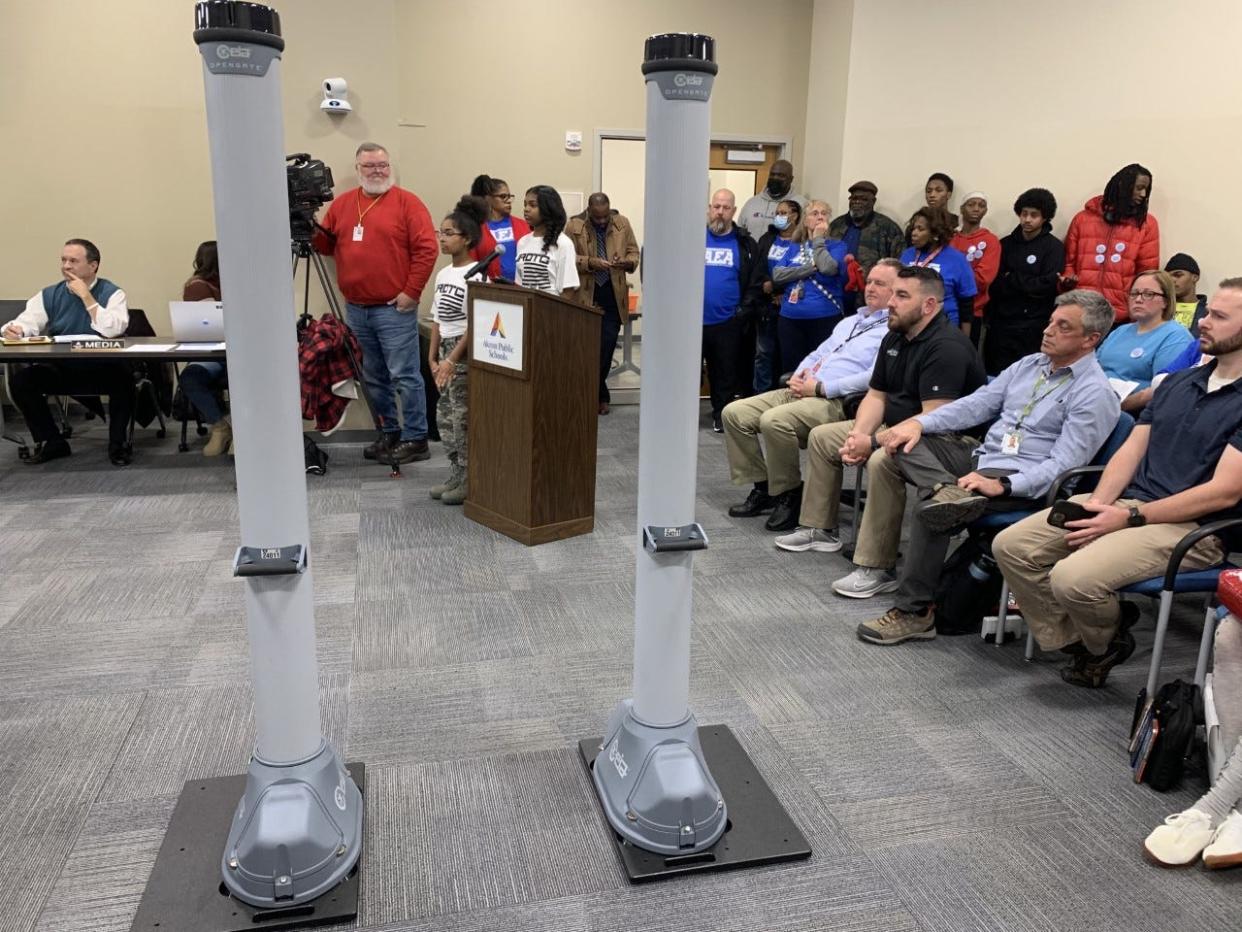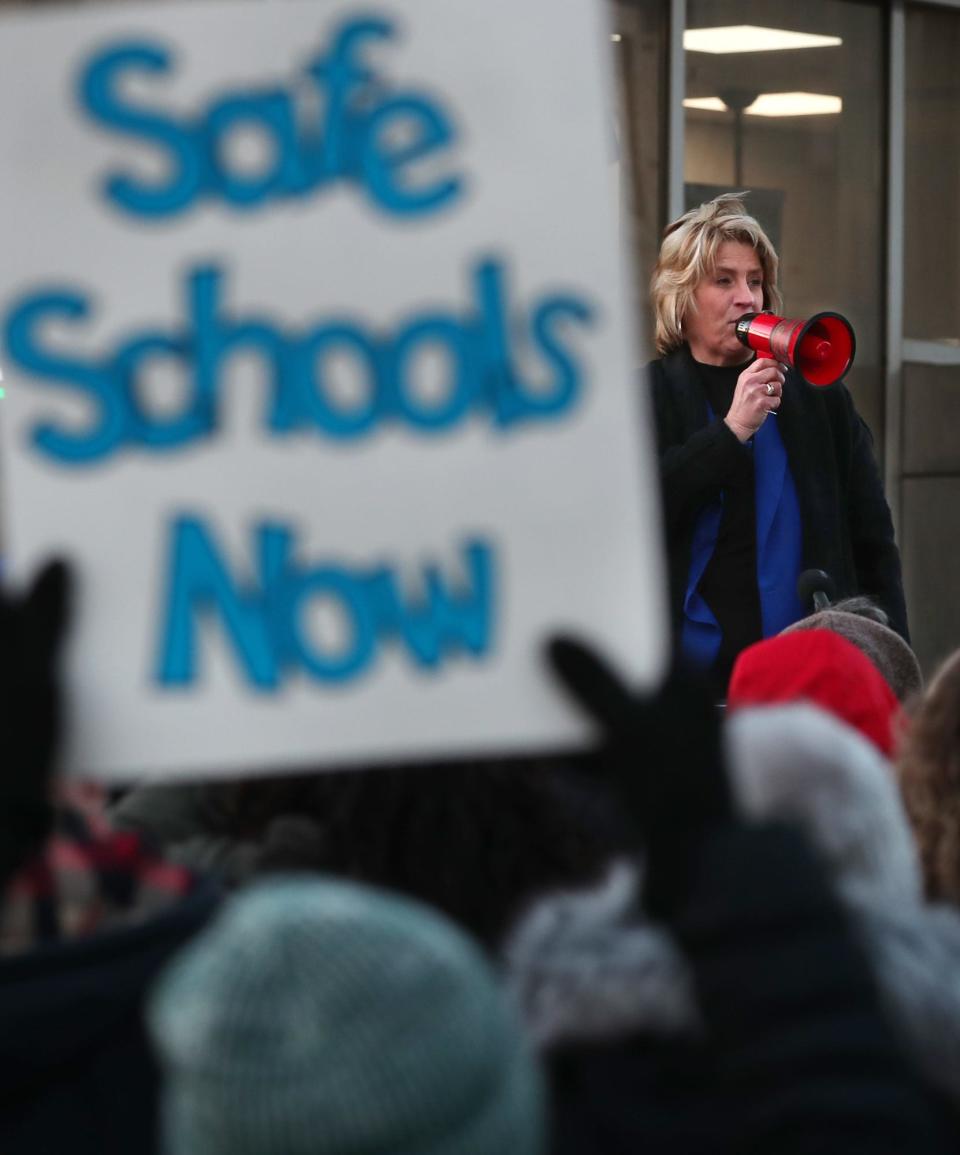Six solutions to make Akron Public Schools safer for students and staff

Take away cellphones and ban social media.
Check every student who gets in trouble for the trauma at the root of their bad behavior.
Free up counselors to counsel instead of spending most of their time scheduling students to attend college and career academies.
Double down on efforts to reach parents.
Harden the schools with artificially intelligent metal detectors and more security staff.
Build relationships.
There’s no shortage of proposed solutions to the rising level of violence and lack of conflict resolution skills among students in Akron Public Schools. The district is experiencing the same uptick in bad behavior and crimes that cities and schools across Ohio and the nation are reporting.
How safe are Akron's schools?Police reports paint disturbing, violent picture
Time to let parents know?Here's how Akron Public Schools decides whether to notify parents, staff about threats
Police reports:We examined 240 reports on incidents at Akron Public Schools. Here's what we found
But competing philosophies on student discipline and limited resources challenge sensible solutions and strain collaboration. Administrators and teachers agree on the need for more effective intervention but disagree on the path to lasting, positive reform.
Meanwhile, fighting in the schools has reached new heights coming out of the pandemic. The district of nearly 22,000 students last school year reported 3,000 notes for fighting in student discipline records. That’s up from 2,869 in the 2018-2019, the last full year before the pandemic, and a 37% increase from the less than 2,200 reported in 2016 or 2017.
Nearly four dozen students have been referred for expulsion in the most severe cases, according to tracking by the teachers union. And about a quarter of these students are on individualized education plans (IEPs) that make it hard or impossible, according to federal law, to discipline them.
Students involved in three or more fights are even more likely to be on behavioral improvement plans, according to a Beacon Journal analysis. More than a third of these 152 students, who account for 11% of all fighters but 34% of all fights, are on IEPs or assigned a federal code for students with disabilities.
When these students get in trouble, teachers meet with special education staff and administrators to determine if the bad behavior is a manifestation of a disability. If so, local administrators cannot expel or suspend them unless a weapon was involved, Chief Operating Officer Steve Thompson said.
Because of federal law, the kid who throws the first punch might get a lighter or no punishment, leading to the perception of "randomness" in how the district disciplines students, Thompson explained. And in cases where discipline is an option, administrators say some students, again because of federal laws protecting students with disabilities, can only be suspended for a total of 10 days each school year. Burn all those days by Christmas break and some students can misbehave the rest of the year without fear of consequence.
"And that's frustrating to people, but that is federal law," Thompson said.
The teachers union says IEPs work if followed but make matters worse if used to excuse bad behavior. The union leaders say building-level administrators might say a behavior has nothing to do with a disability, but they are overruled by central administrators or expulsion hearing officers, resulting in little or no discipline.
Build relationships and trust with all students in APS
The problem also is painted by sensitive issues of race and a culture of distrust.
While sharing what the Beacon Journal found in the police reports with Kemp Boyd, who has coached football at Kenmore-Garfield and mentored students for more than a decade, the Black pastor asked, suspecting they would be overrepresented: “How many of them are Black males?”
Of 1,392 students caught fighting this year, 1,054 are Black, 163 are white and 122 are multiracial. Black children are 46% of all students and 76% of students caught fighting.
And while girls outnumber boys in police reports that cover more severe fights, boys account for 60% of the 1,392 students who’ve fought so far this school year, according to the district data. Black males account for nearly half of all students disciplined for fighting, a long-standing racial disparity that's more prominent in Akron than other major Ohio districts.
As the executive director of Love Akron, Boyd works with schools and other organizations to train staff on identifying "signs and symptoms of a mental health challenge that result from childhood trauma." The "mental health first aid training" program takes 6.5 hours to complete.
Ultimately, though, Boyd said: “Relationship is the greatest intervention.”

Figure out and address the root cause of bad behavior in APS students
The first step is to establish the connection based on trust, said Boyd, who's worked in pastoral counseling for more than a decade. But he’s puzzled as to why the school district does not conduct a social/emotional diagnostic on every child who misbehaves. Dan Richards, a 27-year counselor at the school where Boyd coaches, said there’s no standard test to get to the root cause of every bad behavior.
“Who’s assessing these kids?” Boyd asked. “We have to find some real solutions.”
Red Oak Behavioral Health, an Akron company that partners with the school district to provide counseling services, did not respond to a request for comment on this article. School resource officers employed by Akron police also did not participate in this article, though they provided information to school administrators who forwarded those responses to the Beacon Journal.
Free up counselors' time to truly counsel APS students
Richards said 60-70% of his time as a counselor is consumed by scheduling students to attend college and career academy programs specific to each high school.
“Our counselors are not counseling, they are scheduling kids,” said Richards, who estimated that he and the other two counselors at his high school share the work of about 900 students.
The administration said 300 students per counselor is a common workload in Ohio's larger urban school districts. And counselors consumed by scheduling issues “could be true for the very early part of a school year, but it should not be an ongoing issue for them.”
The district is currently hiring more counselors. And “anyone needing extra resources only needs to ask. There is a process for this,” the administration wrote in response to a written question. (The district also made the chief operating officer, the head of security and an expulsion hearing officer available for a long interview.)
While trauma assessments are not automatic for misbehavior, the district is busy year-round with social and emotional tests for troubled students. An administrative school psychologist shared that 700 students each year receive threat assessments for suicide and self-harm. And 1,000 students are assessed for maltreatment, including neglect and abuse.
District officials said they're in the process of "reviewing and modifying" all alternative programs where students are sent in lieu of punishment, for behavioral interventions or to catch up on credits so they can graduate. That process has frequently changed over the years. Students no longer work with a program run by the YMCA. The Akron Alternative Academy, which once had mandatory group and individual counseling every Wednesday for enrolled students, is now basically a credit recovery program.
While discipline can still mean being transferred to another school, an in- or out-of-school suspension, or expulsion, students given alternatives go to the old staff development center on Steiner Avenue at the Conrad Ott Building. There, they attend the SOAR (Student Outreach Alternative Resource) program, which is not staffed by district teachers.
Students in SOAR do their schoolwork on computers and, administrators say, receive necessary counseling. But union officials say students assigned to SOAR for 60 or 90 days often return to their assigned buildings after 10 or 15 days.
“We see that all the time,” said Richards. “All the time.”
Richards said he’s spoken to five Garfield students who returned from SOAR this year. They all told him they just sat around doing their work online. None spoke of counseling, he said. And parents can opt for the child to stay home instead of attending SOAR.
“We believe that those programs, if we're going to provide services, should be mandatory prior to their transition back into a general education school building,” said Pat Shipe, president of the Akron Education Association teachers union, who is an intervention specialist. “They don't have to. They can go sit at home.”

Shipe also advocates for building-level programs that transition students back to a normal routine when they return from discipline or an alternative program. Some buildings have NOW (No Opportunity Wasted) programs that ease students from containment in a single classroom before gradually releasing them to their full schedules in classrooms spread across the building. A collaborative team monitors the child's response with each new setting added.
"There are not NOW units in every building," Special Education Director Tammy Brady said. "Nor is there a need for that many placements in the most restrictive environment (being a self-contained classroom). APS Student Services does manage the transitions back from alternative programs."
Ban cellphone use in Akron Public Schools
Shipe said a key short-term solution to behavioral issues is enforcement of the district's cellphone policy.
The current policy says classroom teachers can demand that students put away their phones, but they’re often met with defiance and even vulgarity, Shipe said.
“We have more and more fights. And I think a huge component to the uptick in fights is those cellphones that are in secondary buildings, both middle schools and high schools, are an appendage of every student's arm," she said. "You walk through those halls, and they are in the classrooms, they're on their cellphones.”
Asked about the challenges of implementing and enforcing a cellphone ban, district administrators said, “This is something we have been working on. There are quite a few options for addressing this, but we have yet to find one we feel suits what we need.”
Holly Christensen:Akron Public Schools needs to enforce real solutions to behavioral issues
A 2019 Ohio law allows local school boards to set policies on student access to their personal devices. Shipe looks to Dayton Public Schools for a quick answer. The district uses a private company that supplies mesh bags. High school students drop their devices into the bag at the beginning of the day. The bags lock. And the students keep them until the end of the day, when they are unlocked.
Under the proposal, students would continue to access their assignments on school-issued Chromebooks with built-in settings that can be adjusted to restrict the use of apps and the internet.
Install more metal detectors, limit attendance at APS sporting events
Chief Operating Officer Thompson and Director of Safety and Security Don Zesiger said that, with the school board's recent approval of $3 million in upgrades, the first smart metal detectors will arrive this month.
Firestone will get them first, not because a loaded gun was found at the school this year and another next door at Litchfield, the men explained. It's because it takes 75 minutes each morning to screen the 1,200 students at Firestone, which has the highest enrollment in all of APS.
School security:Akron board approves $1.7 million purchase of metal detectors, X-ray machines for schools
"They're consistently missing their first-period class," said Zesiger. "We just can't sustain that."
New metal detectors will use artificial intelligence akin to airport security, Zesiger said. Students will be able to walk through with their book bags. A conveyor belt will eventually screen any bags flagged by the detector.
The district also began using metal detectors at sporting events and, in a recent decision, set attendance limits for basketball games, Thompson said.
Responding as needed are police liaisons who show up to file reports or address specific issues. The district also has 13 uniformed Akron cops embedded as school resource officers and 63 security team members who roam the halls in neon shirts.
Determine ways to engage 'resistant' APS parents
Several police reports reviewed by the Beacon Journal end with an officer's failed attempts to reach the parent or guardian of a student in trouble.
Others involve adults who show up ready to fight the child who injured their son or daughter.
A woman at Buchtel was seen brandishing a gun in the parking lot as staff scrambled to stop a fight scheduled to happen after school, according to social media activity. A woman at Garfield refused to believe there could be video of her son strangling his girlfriend. Instead, she reportedly argued that if the responding officer had been Black, he wouldn't have her son handcuffed to a ring on the wall, which is how she found the boy when she came to pick him up.
Support local journalism:6 reasons why you should subscribe to the Akron Beacon Journal
Another mother kicked off her boots and jumped out of her car as she pulled out of the parking lot of Ellet, according to an officer's report. It was the second day back from Thanksgiving break and the woman wanted to know why Zesiger was recording her leaving with her son, who along with his brother had just been handcuffed and arrested for assault.
Zesiger explained who he was. She hopped back in the car and yelled "(expletive) the police" as she left, according to the officer.
The woman was later charged with helping her son resist arrest. Her sister and a man who showed up in a ski mask, despite the 56-degree weather, were also listed as suspects in the police report.
Reaching families that distrust authority is an ongoing challenge, school officials said.
"We have a lot of family liaisons in schools. We have family connections. We have family meetings," district spokesman Mark Williamson said. "We have groups. We have organizations throughout the city that we partner with that help families who are struggling. I mean, we're a social service agency now.
"There's really no excuse for anybody to complain about not having access to something, because we can get you pretty much anything you need," he continued. "If you just ask, I mean, it's nice if you're polite and all that, but it's a hard thing to do. We offer them every year more and more and more supports. And we still have some of these just resistant parents."
To that point, Director of Student and Family Services Wanda Lash, who also sits in for the superintendent as one of the district's three expulsion hearing officers, said reasonable efforts are made to engage parents.
"The family liaisons are definitely a resource in the building to reach out to our families," Lash said. "I mean, we just keep trying — calls, email, we go to homes if need be."
Reach reporter Doug Livingston at dlivingston@thebeaconjournal.com or 330-996-3792.
This article originally appeared on Akron Beacon Journal: Six ideas to make Akron Public Schools safer for students and staff

